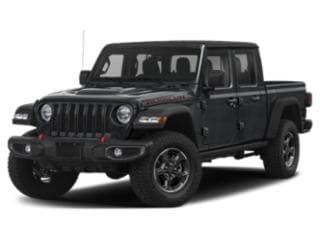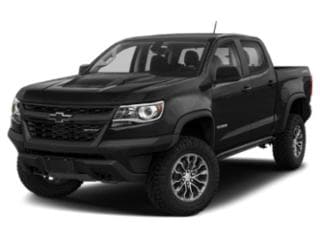2024 Subaru Solterra vs. 2024 Volkswagen ID.4
By Brady Holt
Recent Articles
Popular Makes
Body Types


2021 Jeep Gladiator Overland ・ Photo by Fiat Chrysler Automobiles
Manufacturers keep investing in the mid-size truck market, and these dollars are making a hot segment even hotter. Mid-size trucks are popular, and the Jeep Gladiator — introduced just last year — has fired up serious rivalries with others in the class, including the Ford Ranger, Toyota Tacoma, and Chevrolet Colorado.
Introduced in 2015, the second and current generation of the Colorado brought the first diesel engine to the segment. Now, Jeep is launching a rival, the 2021 Gladiator EcoDiesel. These small trucks don’t offer the size, power, and capability of full-size turbo-diesel trucks from Chevy and Ram, but they’re ready to work hard and play even harder. Plus, they generally cost less, are more fuel-efficient, and are easier to park. But which is best? Let’s examine the 2021 Jeep Gladiator EcoDiesel and 2020 Chevy Colorado diesel in key areas and decide.
The exterior design of the Chevrolet Colorado hasn’t changed much since 2015. The truck is still attractive, with chunky fenders and a powerful face. But it’s also quite familiar at this point, which keeps it from getting as much attention on the road as it once did. The turbodiesel engine is available in all three Colorado body styles, and on the off-road-ready ZR2 model, which looks the business with big fender flares, a special front bumper, and a hood bulge.
Jeep’s reimagined Jeep Gladiator was introduced just last year, and it’s the brand’s first pickup since 1992. It shares much of its exterior design, as well as its mechanical hardware, with the Jeep Wrangler Unlimited, and it looks more severe than the Chevy. Far boxier than any of its rivals, the Gladiator’s look is classic Jeep. It isn’t for everyone, but it’s a head-turner, love it or leave it, and you won’t mistake it for anything else. It’s also the only convertible pickup on the market. All Gladiators are crew cabs with four doors, and you can get the diesel engine on all models except the Mojave.
Jeep Gladiator
Photo by Fiat Chrysler Automobiles
Both trucks are very comfortable and offer nearly as many luxury options as you’re willing to pay for, like heated front seats and navigation systems. Their seats are well-shaped and their cabs are surprisingly roomy. You don’t need a full-size truck if a spacious cabin is a high priority. You won’t feel cramped in the Chevy or the Jeep. Though we prefer the interior design of the Gladiator, we find the Colorado to be just a bit more comfortable and give it an edge in this category. It has a slightly better driving position, and we find it to be a little easier to get in and out of.
Chevy offers the Colorado with either a 5-foot or 6-foot bed, while every Gladiator has a 5-foot bed. With the turbodiesel engine, the Colorado’s payload ratings range from 1,430 to 1,510 lbs while the Gladiator EcoDiesel’s maximum payload ranges from 1,075 to 1,325 lbs. The Chevrolet can also tow more weight. Although the Jeep has more torque, the Colorado can tow 7,700 lbs. while the Gladiator is rated to pull a maximum of 6,500 lbs. Chevrolet also offers its diesel engine with two or four-wheel drive, while every Gladiator is a 4x4.
Photo by General Motors
Chevy equips the base Colorado with a 7-inch touchscreen, while the LT, Z71, and ZR2 models get an 8-inch unit. Navigation is available and the trucks all feature a 4G WiFi hotspot, Android Auto and Apple CarPlay. Wireless charging is standard on Z71 and ZR2.
The base Gladiator Sport gets a 5-inch screen. The Overland and Rubicon get a standard 7-inch unit, but an 8.4-inch touchscreen is optional. Both feature Android Auto and Apple CarPlay, while the largest screen also adds navigation with pinch-and-zoom and onboard Wi-Fi. The two systems offer similar graphics quality and features, and both are quick to respond and very intuitive to use.
Tie
Photo by Fiat Chrysler Automobiles
Neither of these trucks lathers on the high-tech accident avoidance technology. Chevrolet offers an optional Safety Package on LT and Z71 models, which includes a forward-collision warning, a lane-departure warning, and rear parking sensors. The Gladiator is available with adaptive cruise control with a forward-collision warning, blind-spot monitoring, and rear parking sensors.
The National Highway Traffic Safety Administration awarded the Colorado an overall safety rating of four stars out of five, and the Chevy did well in six out of seven evaluations performed by the Insurance Institute for Highway Safety. Neither NHTSA nor IIHS have crash-tested or rated the Jeep, so we’re going to give the Chevy a slight victory here.
Chevrolet Colorado
Photo by Chevrolet
Chevy’s turbocharged 2.8-liter diesel, which is also available in the GMC Canyon, makes 181 hp at 3,400 rpm and a stout 369 lb-ft of torque at 2,000 rpm. This four-cylinder engine is backed by a well-tuned six-speed automatic, while the truck’s gasoline V6 partners with an excellent eight-speed. It isn’t very quick, but it doesn’t feel underpowered either. With the diesel, a 4WD Colorado takes about 9 seconds to reach 60 mph.
Under the hood of the Gladiator is a 3.0-liter turbocharged V6, and it puts out much more power than the Colorado: 260 horsepower at 3,600 rpm and 442 lb-ft of torque at just 1,400 rpm. It’s also paired with a more sophisticated 8-speed automatic. It’s also much livelier than the Chevy’s diesel, thanks to its larger displacement and lack of turbo lag. The Jeep hits 60 mph in about 7 seconds.
Jeep Gladiator
Photo by Fiat Chrysler Automobiles
With the diesel, the Colorado’s fuel economy estimates are 20 mpg in the city and a class-leading 30 mpg on the highway with 2WD, and 19 mpg city and 28 mpg highway with 4WD. That makes it by far the most fuel-efficient Colorado available.
The more powerful Gladiator isn’t far behind thanks to its more sophisticated transmission. Its fuel economy estimates are 22 mpg city and 28 mpg highway for the Sport and Overland models, and 20 mpg city and 25 mpg highway for the Rubicon. So the Gladiator actually gets better mileage than the Chevy around town.
Jeep Gladiator
Photo by Fiat Chrysler Automobiles
The Colorado is the more carlike of these two trucks from behind the wheel. It’s athletic and responsive and quite fun-to-drive with quick steering a well-tuned suspension. It feels sturdy and substantial on the road, like a truck should, but it doesn’t feel clumsy or overly heavy. Even the 4x4 models don’t knock you around unnecessarily, though the Gladiator Rubicon does ride better than the Colorado ZR2.
By comparison, the Gladiator feels more like a truck. Now, it isn’t a rough ride and it isn’t afraid of a twisty road, but it doesn’t feel as carlike as the Chevy. For many buyers this is a good thing. They want their truck to be comfortable and capable, but they also want to know they’re driving a truck. But we prefer the Colorado’s superior handling.
Chevrolet Colorado
Photo by General Motors
Chevy’s most affordable diesel model is the short-bed crew cab 2WD LT, which has a base price of $37,810. The Duramax turbo-diesel engine costs $3,500 extra. Add 4WD, which is standard on the Jeep, and you’re looking at $41,275. With the diesel engine, the ZR2 — which is the ultimate off-road Colorado — starts at around $47,895.
Jeep charges you $4,000 for its diesel engine and forces you to pay another $2,000 for the automatic transmission. A six-speed manual is standard with the gasoline engine, but it isn’t available with the EcoDiesel. The base price for a diesel-powered Gladiator Sport is $41,040. If you want a Rubicon for ultimate off-road capability, it’s $51,615. So the Colorado is the cheaper of the two, but line them up 4x4 to 4x4, and they cost about the same.
Tie
Photo by Fiat Chrysler Automobiles
This shootout is too close to call. Each truck has won three categories and they’ve tied in two. Overall, the diesel versions of the 2020 Chevrolet Colorado and 2021 Jeep Gladiator are two very impressive trucks. They both offer compelling designs, hardware, dynamics, and capability. The Chevy wins us over with its more comfortable interior, its greater rear legroom, carlike dynamics, and superior payload and towing capability, while the Jeep’s styling, power, acceleration, and fuel economy are better.
We also applaud Chevrolet for offering a crew cab with a longer 6-foot bed, while the Jeep’s top goes down for those sunny days. Both trucks offer excellent infotainment systems, and they cost about the same once you add four-wheel drive to the Chevy. Choosing between the two is a matter of taste, priorities, and personal preference.
Tie
Photo by General Motors
Car of the Day
Resources
©2025 AutoWeb, Inc. All Rights Reserved.
Some content provided by and under copyright by Autodata, Inc. dba Chrome Data. © 1986-2025.